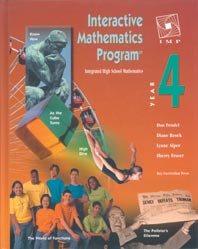Thank you for visiting this blog.
Unfortunately, the time has come for me to move on. Dr. Powers has allowed me to be on-loan from Jones so that I can work at Harper High School. I will be a Lead Teacher for the Teacher Advancement Program, which has received national recognition from President Obama. I am extremely excited by this opportunity.
I can still be reached via my CPS email. And please, check out my new blog.
Saturday, July 11, 2009
Moving On...
Posted by
MR. MARTI
at
11:35 PM
0
comments
![]()
Friday, July 10, 2009
The formula for changing math education
What do you think?
Posted by
MR. MARTI
at
5:57 PM
0
comments
![]()
Monday, June 29, 2009
FAMOUS...
Its finally here...you know YOU DA YOU DA BEST...
WORLDWIDE ENTERTAINMENT
If I had known, I would have worn something better...
Link to our now infamous Jones Lesson Study video.
Can you see whose sleeping?
Posted by
MR. MARTI
at
12:33 PM
0
comments
![]()
Friday, June 19, 2009
Saturday, June 6, 2009
Did you know....
that only 33% of students graduate from Columbia College?
that only 50% of students graduate from UIC?
that only 16% of students graduate from Chicago State University?
Here is a link with the list of Illinois Universities.
Here is a link that has nationwide universities.
Comments?
Posted by
MR. MARTI
at
12:46 PM
0
comments
![]()
Friday, June 5, 2009
Summer's Here
Finally?...Can it be?....The death of the autotune?...I guess we have to wait and see...
Mr. Remiasz is trying to schedule summer sessions for AP Calc BC. Send him an email if you didn't meet with him before the end of school.
This is how I will always remember summer....
Posted by
MR. MARTI
at
9:07 PM
0
comments
![]()
Tuesday, June 2, 2009
CALCULUS PACKETS
Visit our homework site to find copies of various calculus packets.
Do you have any questions?
Here are additional ones if you get bored.
packet
packet
Blackle "calculus summer packet" for even more.
Posted by
MR. MARTI
at
7:46 AM
3
comments
![]()
Tuesday, May 12, 2009
WOF Portfolio
Here is a site that explains how to graph piecewise functions on the TI calculator.
Say my equations is
Y1 = -(X-2)^2 + 4
If you graph that equation, then you will see that the function has negative values when x <= 0 and when x>= 4. If you only wanted the positive values, you can enter that into the calculator by typing:
Y2 = (Y1)(X>=0)(X<=4)
NOTE: Type all of the parentheses. Use VARS -> Y_VARS -> Functions -> Y1 to enter Y1 and 2ND -> MATH -> 4 to enter >=.
Some other cool things with the calculator...type:
Y3 = Y2(X-2)
Note the placement of the parentheses. What happens? This is like doing f(x-2) or shifting the function 2 spaces to the right. Look at the table to verify this.
You could also combine functions...type:
Y4 = Y2 + Y3
What happened? Look at the table to verify this.
Posted by
MR. MARTI
at
2:23 PM
7
comments
![]()
Wednesday, May 6, 2009
Almost Done with WOF
Just one more topic to go....
Transformation of graphs...some books like to say translation.
Here is a link that describes shifts, stretches, and shrinks. Here is another link. This is a cool powerpoint presentation. And finally, here is a pdf file.
Here is an interactive site.
Posted by
MR. MARTI
at
2:29 PM
0
comments
![]()
Thursday, April 30, 2009
Saturday, April 25, 2009
Combination of Functions
I found this "cool" website. Here is a video on combining functions. You may want to fast forward to around the 5:50 mark -- he starts to describe composing functions, which is our next topic.
Watch the 250K version.
Here is a page of over 60 precalc videos.
Posted by
MR. MARTI
at
9:41 PM
1 comments
![]()
Monday, April 20, 2009
Did you know...
...that there will only be four trig questions on the ACT Math Test, so even if you aren’t comfortable with trig, it won’t destroy your Math score. The topics of trigonometry covered by the ACT are:
- SOHCAHTOA
- Solving Triangles
- Trigonometric Identities
- Trigonometric Graphs
I got this from SparkNotes. So I was interested in the other questions and I found this:
- 14 questions w/ pre-algebra
- 10 questions w/ elementary algebra
- 9 questions w/ intermediate algebra
- 9 questions w/ coordinate geometry
- 14 questions w/ plane geometry
- 4 questions w/ trigonometry
Posted by
MR. MARTI
at
12:50 PM
1 comments
![]()
Saturday, April 18, 2009
ACT Prep II
 A student asked for some information on probability.
A student asked for some information on probability.
Here is a link.
Here is another link.
Does that help?
I also found this on ACT's website. It has some more practice tests, if you need them.
As you probably are already aware, here are the topics covered in the math portion of the ACT test.
And how about this...On the Math Test, a D+ Is a Pretty Good Grade!
SparkNotes also has a good review section.
Posted by
MR. MARTI
at
5:19 PM
0
comments
![]()
Friday, April 17, 2009
ACT Prep
Someone asked about some of the questions on circles.
Here is a good site. It is a link to the Regents test, a test that high schoolers in New York must pass in order to graduate. Should Illinois have a similar test that you must pass?
Here is an interactive site.
Here is some information on ellipses.
And finally, here is a review of conics.
Does this help? If not, leave me an email or comment.
Any other questions on the ACT prep pages Ms. Fulton and Mr. Bywater put together?
Posted by
MR. MARTI
at
3:31 PM
0
comments
![]()
Combining and Modifying Functions

Our last outcome for WOF is combining and modifying functions.
Here is a site that talks a little about it. And here is another link.
Does anyone have other resources?
What would a function machine look like for f(g(x))?
Posted by
MR. MARTI
at
2:38 PM
0
comments
![]()
Wednesday, April 15, 2009
Everything You Need to Know to be successful in Calculus
Here is the magical video.
What do you think? Do you think this video told you everything?
Posted by
MR. MARTI
at
10:54 PM
2
comments
![]()
How to find the Specific Functions
What techniques did we try in class today?
How are you going to find the specific function on our quiz this Friday?
Posted by
MR. MARTI
at
3:40 PM
1 comments
![]()
Finding Specific Quadratic Functions
Here is a cool video on how to find the specific quadratic function when given 3 points.
Posted by
MR. MARTI
at
2:46 PM
0
comments
![]()
Tuesday, April 7, 2009
Research says...
Anyway...
I was doing some research. I will be teaching an abridged PreCalculus class this summer. I have several questions that rattle through my head...
What should I teach?
How much of High Dive do my students remember?
How much of High Dive is important for my students' success in Calculus?
I found this article. Here are some excerpts:
"If students are to remember what they learn, the courses they take must tell a coherent story...Precalculus courses often run the risk of not being memorable because they are defined as the skills needed in calculus rather than telling a coherent story...No matter what flavor of calculus course they take, students benefit from a precalculus course that emphasizes interpretation as well as calculation...Particularly for students who are repeating material that they did not fully master before, a focus on meaning is an essential part of making the ideas fit together and finally stick."
Do you feel that your current Precalculus class "tells a coherent story"? Or is there more of an emphasis on the calculations? Do you think you are mastering the material?
Additionally, since you have experienced both "traditional" and "reform" (IMP) math curriculum, how should the AP Calculus class be taught? What are the pro's and con's of continuing to use our traditional Calculus curriculum? Of switching to a reform Calculus curriculum?
Here is a research paper examining the University of Michigan's Calculus classes, which use a "reform" textbook created by Harvard University.
Posted by
MR. MARTI
at
10:20 AM
1 comments
![]()
Friday, April 3, 2009
Spring Break...
I'm on a world tour with my book in my hand...
Any questions about the High Dive Unit Exam? Your portfolio?
Posted by
MR. MARTI
at
2:55 PM
0
comments
![]()
Sunday, March 22, 2009
More about Quadratic Functions
This is a really good site. There are some table to practice finding the second difference. Several students are incorrectly calculating the differences, which will become more important as we try to find the specific equation. Surf around the site, there is information on linear and exponential functions. Here is another good page from that site.
The first part of this site is good as well.
Posted by
MR. MARTI
at
6:55 PM
0
comments
![]()
Thursday, March 19, 2009
Thursday, February 12, 2009
Bored?
If you ever feel bored in class and want to be challenged, just let me know.
I will keep a list of advanced topics here that we can examine at outside of class.
Posted by
MR. MARTI
at
11:13 AM
0
comments
![]()
Sunday, February 8, 2009
Kinematic Videos
Here are some videos from a physics class.
Note: They use 10 m/s^2 (sometimes 9.8 m/s^2) for the acceleration of gravity. In our class we are using 32 ft/s^2
Here is a link to a presentation on vectors. It is really good.
Posted by
MR. MARTI
at
6:56 PM
0
comments
![]()
Wednesday, February 4, 2009
Quiz Friday

Quiz this Friday. Topics that are fair game include:
- Solving quadratic equations with either exact answers or decimal equivalent
- Solving for distance traveled for a moving object
- Solving for the final velocity of a moving object
- Solving for the time it takes a moving object to move a certain distance
Are you ready? Questions?
Posted by
MR. MARTI
at
2:38 PM
0
comments
![]()
Tuesday, February 3, 2009
Monday, February 2, 2009
Look Out Below
Its been a long time....
Today, we reviewed the answers to Look Out Below
1. 1 sec = 50 ft/sec; 2 secs = 70 ft/sec
2. Avg speed is 50 ft/sec (How did we get this?)
3. Travel 100 feet in 2 secs (Can you use the area model to get this?)
4. 3.2 secs to fall 200 feet (Can you use the area model to get this? -OR- Can you use the equation below to get this answer?)
5. h(t) = 200 - 10t^2 - 30t. This is derived from the physics formula that some students remember: displacement = 0.5*a*t^2 + vi*t
The top of this page has more information on the formulas we are interested in.
Here is a site that can help with the physics concepts. We also proved some of them in the assignment "FreeFall".
Posted by
MR. MARTI
at
2:27 PM
0
comments
![]()
Thursday, January 8, 2009
HW20 and 21
Look here for the book's answers to HW20.
Posted by
MR. MARTI
at
2:35 PM
0
comments
![]()
Wednesday, January 7, 2009
Tuesday, January 6, 2009
Identities
Here are some sites for trig identites...
Sine
Cosine
Tangent
This site has a quiz to test your skills. Here is another.
Posted by
MR. MARTI
at
2:31 PM
0
comments
![]()








